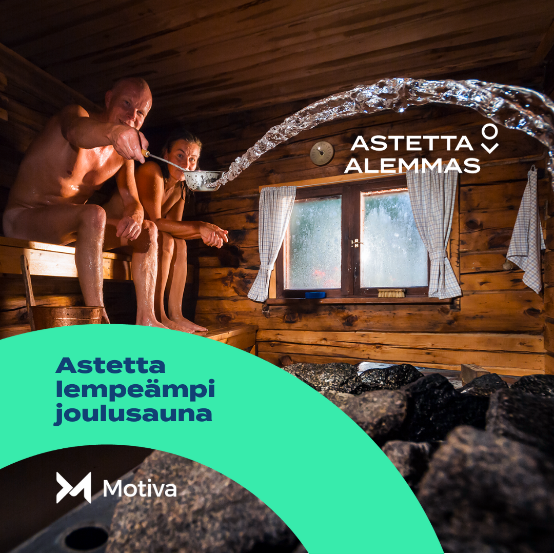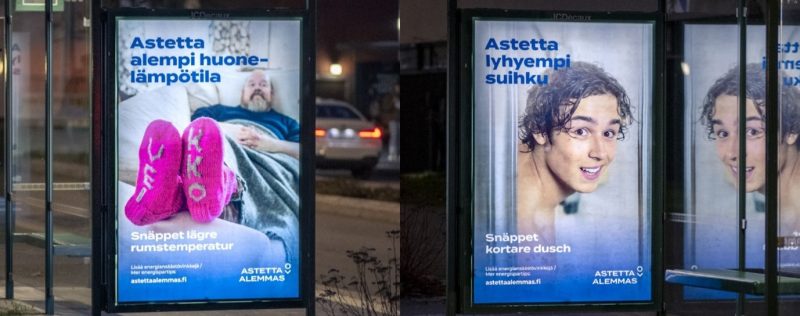Case Study Overview
The Finnish campaign was launched during the 2022-23 heating season in response to significant energy price increases resulting from sanctions on energy imports from Russia. The government, working together with the Finnish Innovation Fund, Sitra, encouraged households to save energy and improve energy efficiency to alleviate the effects of future energy bills.
Design
Target audience: The campaign targeted all Finns at home, at work, and in educational institutions. Non-governmental organizations, municipalities, and businesses were also encouraged to save energy and share relevant energy-saving tips with their employees and stakeholders.
Prior to the launch and throughout the campaign, communications materials were tested to assess the effectiveness of the messages, the call to action and the visual design. A survey was carried out to monitor the citizens’ perception of energy saving advice every five weeks, as a part of a broader survey conducted by the government.
Objectives and message: The campaign encouraged households to change their energy and electricity consumption habits to reduce the overall energy demand. The main message of the campaign was “Down a Degree. So that there will be enough energy for all of us.” The message focused on a collective commitment and was supported by the involvement of a wide range of companies, organisations, communities, municipalities, and associations operating in different sectors to perform energy-saving actions as part of the campaign. The message of the campaign was encouraging and straightforward; it aimed to speak to everyone in a motivating and unifying way. It emphasised that saving energy could help combat an external threat posed by Russia. The actions promoted by the campaign were clear and easy to implement.
Resources: The campaign funding came from a number of sources, namely the Energy Authority, the Ministry of Economic Affairs and Employment, the Ministry of the Environment, the Prime Minister’s Office and the Finnish Innovation Fund Sitra. The project was coordinated by the state-owned sustainable development company, Motiva, which mobilised the necessary networks, ready-made structures and operating models for extensive campaign work. The Energy Authority’s energy work programme, as well as the national Energy Saving Week, formed a well-positioned platform with strong expertise for campaign work. Motiva’s core team included four communications and marketing experts and two energy experts. From the planning stage, Motiva’s national advice service and regional energy advisers acted as support for the “Down a Degree” campaign.
The most important lesson: Having an established a functioning basis for energy saving communications and advice was key to the success of the campaign. The long-standing cooperation between the Ministry of Economic Affairs and Employment, the Energy Authority and Motiva on the issue of energy savings created a unique platform and operating model that was leveraged during the energy crisis.
The decision to invite other partners to participate in the campaign proved to be a crucial success factor. Additionally, having sufficient funding and human resources dedicated to the campaign was also essential. The campaign narrative was strongly connected to Russia’s war on Ukraine and the ‘toughness’ of Finns in the face of the aggression, which made it possible to build an emotional message.
Implementation
Media channels used: Advertising channels were selected based on the potential reach and target audience. The campaign launched a stand-alone website with pages in Swedish and English, in addition to the Finnish-language material. On social media, the campaign’s own account as well as Motiva–managed accounts on X (formerly Twitter), Facebook and Instagram were extensively used. Additionally, the campaign cooperated with a TikTok influencer to further expand its audience
 Recommended measures: The campaign promoted a wide range of measures aimed at households and companies. This included recommendations for homes, such as lowering thermostat setpoint and minimising the use of the sauna as well as tips for transport, offices and shops.
Recommended measures: The campaign promoted a wide range of measures aimed at households and companies. This included recommendations for homes, such as lowering thermostat setpoint and minimising the use of the sauna as well as tips for transport, offices and shops.
Stakeholder involvement: The campaign engaged various networks and reached out to organisations already committed to energy efficiency to promote the implementation of the campaign’s measures. The campaign’s steering group worked closely with Fingrid, a national grid operator. The campaign prioritised media offering national visibility pro bono, or under a reduced price of the advertising space. To ensure consistent communication, campaign partners were kept informed and provided with a weekly newsletter, that included the latest campaign news, updates on the energy situation, content and material tips and partner presentations.
The most important lesson: Networks and partners are an essential resource to multiply communication channels and significantly improve the reach of the campaign. Cooperation across sectors and industries coupled with existing partnerships worked effectively. All stakeholders promoted the same message, which was essential given that communication concerned the whole of society

It is worth investing in building a good cooperation with the media; providing up-to-date, quick and reliable information for the use of the media is absolutely essential. Social media proved to be an important channel to convey campaign’s messages, but the effectiveness was difficult to measure. Each social media channel has its unique characteristics, therefore the tone of the content and the types of user profiles should be researched in advance for each channel. The goal should not be trying to appear in all possible social media channels but rather identifying where the maximum impact can be achieved. The competition for visibility on social media is fierce, and without dedicated advertising investment, it is difficult to stand out from the crowd.
Tracking
Impacts: Households reacted quickly to the rise in electricity prices and energy-saving tips, which were also widely published by the media in late summer 2022. As of September 2023, as many as 86% of citizens reported they had taken energy-saving measures. External reviews of the campaign are available from the University of Helsinki and Arcada University College.
Outcomes: Several targets were set, including peak hour energy use reduction and citizens’ participation in savings actions, which were monitored with regular surveys. The campaign communicated the outcomes using figures on implemented measures and achieved savings. This helped maintain the motivation.
The most important lessons: It is essential to assess the results along the way, even though collecting data is challenging, and the statistics are not always comparable. Based on data, additional activities and resource should be directed to the communications channels that produce the best results in terms of engagement. The timing and duration of the campaign also played a decisive role in its success. The topic attracted most interest from the summer of 2022 until the early winter of 2023; the interest waned after March 2023. It is not advisable to extend a campaign for a long period of time; instead, it should be re-launched when the issue becomes more topical
Table Heading
| Agency | Motiva |
| Slogan | Down a Degree (“Astetta Alemmas”) |
| Website | https://www.astettaalemmas.fi/en |
| Contact person | Kati Laakso (kati.laakso@motiva.fi) |


